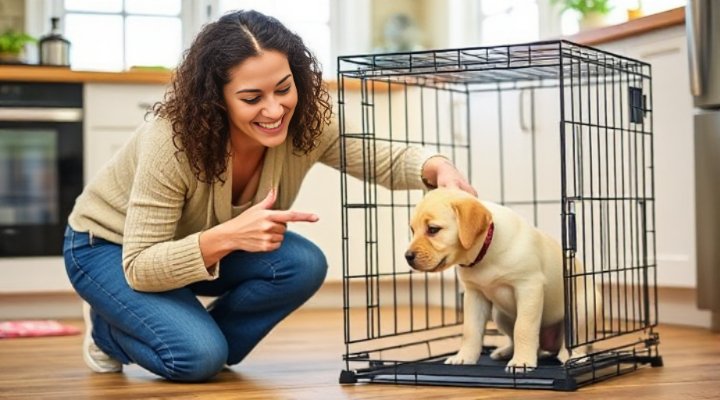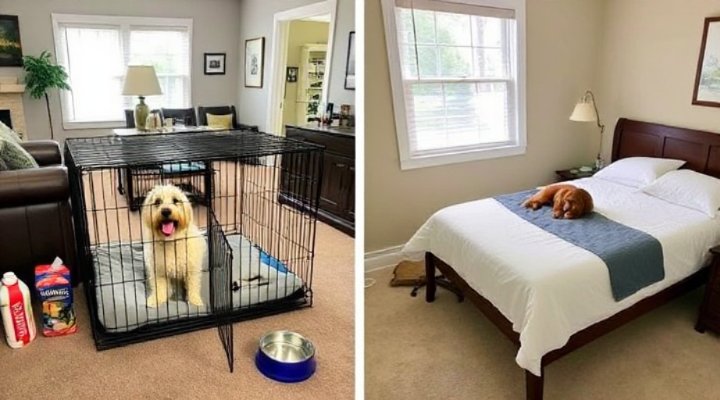Crate training is one of the most effective ways to help your dog feel secure while teaching good behavior. When done properly, it creates a safe space your dog will love. In this comprehensive guide, we’ll walk through every step of the process to ensure success.
Why Crate Training Works So Well
Dogs are naturally den animals, meaning they instinctively seek out small, enclosed spaces for security. A properly introduced crate taps into this instinct, becoming your dog’s personal retreat. According to the American Veterinary Medical Association, crate training can significantly reduce anxiety and destructive behaviors when implemented correctly.

Choosing the Right Crate
Selecting the appropriate crate is crucial for successful training. The crate should be large enough for your dog to stand, turn around, and lie down comfortably, but not so big that they can use one end as a bathroom. For more details on selecting the perfect crate, check out our guide on how to choose the right dog crate.
Types of Crates
- Wire crates: Provide excellent ventilation and visibility
- Plastic crates: Offer more privacy and are airline-approved
- Soft-sided crates: Great for travel but not for chewers
- Heavy-duty crates: Ideal for powerful chewers or large breeds

Introducing the Crate
The key to successful crate training is making positive associations. Start by placing the crate in a common area where your family spends time. Leave the door open and scatter treats inside to encourage exploration. Never force your dog inside – this creates negative associations that can undermine your training efforts.
For puppies especially, gradual introduction is vital. Our article on puppy crate training offers specific tips for young dogs.
Step-by-Step Introduction
- Place treats near the crate entrance
- Gradually move treats further inside
- Feed meals near or inside the crate
- Begin closing the door briefly while you’re present
- Slowly increase duration as your dog becomes comfortable

Establishing a Routine
Consistency is crucial in crate training. Dogs thrive on routine, so establish regular times for crate use. Typical schedule points include:
- After playtime/exercise
- During meals (if feeding in crate)
- When you leave the house
- At bedtime
Remember, the crate should never be used as punishment. It should always remain a positive space. If your dog shows signs of anxiety, our guide on solving dog anxiety issues can help.
Common Crate Training Challenges
Even with perfect preparation, you may encounter some hurdles. Here’s how to handle common issues:
Whining or Barking
If your dog vocalizes in the crate, ensure their needs are met (potty break, exercise, etc.) before responding. Reward quiet behavior with treats and praise.
Accidents in the Crate
This usually indicates the crate is too large, the dog was left too long, or needs more frequent potty breaks. Clean accidents thoroughly with enzymatic cleaner to remove odors.

Advanced Crate Training Tips
Once your dog is comfortable with basic crate use, you can enhance the experience:
- Rotate special crate-only toys to maintain interest
- Use calming pheromone sprays designed for dogs
- Play soft music or white noise when leaving
- Practice short departures to prevent separation anxiety
The American Kennel Club recommends using crate training as part of comprehensive obedience training.

When to Phase Out the Crate
While many dogs enjoy their crates throughout life, you may eventually phase it out. Signs your dog is ready include:
- Consistent good behavior when loose
- No destructive tendencies
- Reliable house training
- Choosing to sleep outside the crate voluntarily
Remember, every dog is different. Some may always prefer their crate as a safe space. For more on understanding your dog’s needs, see our article on how dog whisperers understand canine behavior.
Final Thoughts on Crate Training
When implemented with patience and positivity, crate training provides numerous benefits for both dogs and owners. It creates a safe haven for your pet while preventing destructive behaviors and aiding in house training. Remember to always associate the crate with positive experiences, and never use it as punishment.
With consistent practice, your dog will come to view their crate as a personal retreat – what could be better than that?
Related Keywords: dog crate training, puppy crate training, how to crate train a dog, crate training benefits, dog crate size, crate training schedule, crate training problems, dog anxiety solutions
